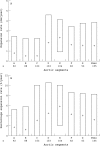Clinical and patho-anatomical factors affecting expansion of thoracic aortic aneurysms
- PMID: 10956290
- PMCID: PMC1760947
- DOI: 10.1136/heart.84.3.277
Clinical and patho-anatomical factors affecting expansion of thoracic aortic aneurysms
Abstract
Objective: To examine the expansion of aneurysmal aortic segments (> or = 35 mm) and to assess the impact of clinical and patho-anatomical factors on aneurysm expansion.
Design: 87 consecutive patients (mean age 63.6 years, range 22-84 years) were studied using serial (six month intervals) computed tomographic or magnetic resonance imaging to monitor progression of thoracic aortic aneurysms. Aortic diameter was measured at seven predetermined segments and at the site of maximum aortic dilatation (MAX).
Results: 780 segment intervals were identified. The median overall aneurysm expansion rate was 1.43 mm/year. This increased exponentially with incremental aortic diameter (p < 0.01) and varied by anatomical segment (p < 0.05). The presence of intraluminal thrombus (p < 0.01) but not dissection or calcification was associated with accelerated growth. Univariate analysis identified thrombus (p < 0.001), previous stroke (p < 0.002), smoking (p < 0. 01), and peripheral vascular disease (p < 0.05) as factors associated with accelerated growth in MAX. Dissection, wall calcification, and history of hypertension did not affect expansion. beta Blocker treatment was not associated with protection. Multivariate analysis confirmed the positive effect of intraluminal thrombus and previous cerebral ischaemia, and the negative effect of previous aortic surgery on aneurysm growth. These findings translated into a mathematical equation describing exponential aneurysm expansion.
Conclusions: Aneurysmal thoracic aortic segments expand exponentially according to their initial size and their anatomical position within the aorta. The presence of intraluminal thrombus, atherosclerosis, and smoking history is associated with accelerated growth and may identify a high risk patient group for close surveillance.
Figures





References
MeSH terms
LinkOut - more resources
Full Text Sources
Other Literature Sources
